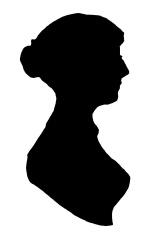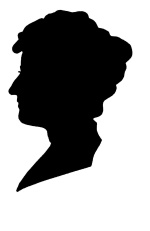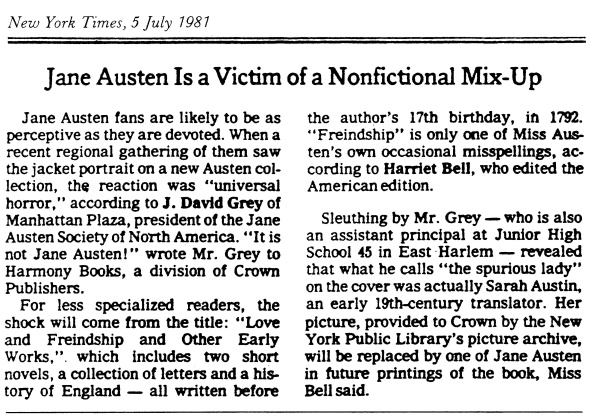|
Persuasions #3, 1981 Pages 12-13
The recent publication of a new edition of Love and Freindship, with a portrait on the cover of someone who was not Jane Austen, sent shock waves through the ranks of Austen lovers everywhere. Our President, J. David Grey, established the identity of the “wrong” picture, which turned out to be that of Sarah Austin, a nineteenth-century translator and writer on education, – a lady well-known in her day, but not the author of the book in question. Portraits of the real Jane Austen are few. One of the most familiar is the engraving reproduced on the JASNA letterhead, which shows her looking a little to her right, wearing a ruffled cap, with a small frill drawn up around her neck by a narrow ribbon. However, many people do not realize that this particular portrait is not a picture of Jane Austen made during her lifetime, but an imaginary reconstruction. It was engraved from a drawing made by a Mr. Andrews of Maidenhead, to be used as a frontispiece for the publication in 1870 of the Memoir of Jane Austen by her nephew, James Edward Austen-Leigh. When the Rev. Mr. Austen-Leigh was preparing his work for the press he submitted Mr. Andrews’ drawing to Jane’s nieces, who had known her as children, and we have Dr. R. W. Chapman’s authority that they gave it only “very guarded and qualified approval: it was not positively inconsistent with their youthful recollections; perhaps it gave some idea of the truth.” One would like to know what James Edward’s own opinion was – he was eighteen when his aunt died, and had known her well. Mr. Andrews based his picture on the only surviving authentic record of Jane Austen’s features drawn from life. This is the pencil sketch, with the face and hair in watercolors, made by her sister Cassandra. It is now one of the proudest possessions of the National Portrait Gallery in London, whose experts have tentatively dated it about 1810. This little sketch is both slight and amateurish, yet it breathes life, – Jane herself sat for it, and Cassandra’s hands made the drawing and applied the faint color. These three versions – Cassandra’s c. 1810 sketch, the Andrews drawing, and the 1870 engraving – have all been used many times as illustrations in books and magazines. The only other actual picture we have that may be of Jane Austen is another tinted drawing by Cassandra, signed and dated “C.E.A. 1804” It represents in profile a lady sitting down outdoor’s, but unfortunately the lady’s sunbonnet almost completely conceals her face, so that if she is Miss Austen the picture doesn’t help us to know what she looked like. In identifying this as Jane Austen, Dr. Chapman relies on the evidence of a letter of 1862 from Jane’s niece Anna Lefroy to James Edward Austen-Leigh, referring to “a sketch which Aunt Cassandra made of her in one of their expeditions – sitting down out of doors on a hot day, with her bonnet strings untied.” Perhaps it is Jane, – but one could wish that she had taken her bonnet off! Another candidate is a “portrait of Jane Austen the novelist by Zoffany,” reproduced in Lord Brabourne’s edition of the Letters in 1884, and again in a biography published in 1913. This shows a very young girl, hardly more than a child, wearing a dress which costume historians have dated at 1805 or later; it is widely thought that it cannot be Jane Austen on the grounds that as she turned thirty in 1805, the date of the dress and the age of the sitter make this impossible. A booklet on sale in the shop at Winchester Cathedral carries on its cover a silhouette said to be of Jane Austen. The original, which has inscribed on the back that it was “done by herself in 1815,” was given to the Dean and Chapter of Winchester in 1936 by Miss Jessie Lefroy. (On the right above) There is only one more possibility. In 1944 a bookseller found volumes 1 and 2 of the second edition (1816) of Mansfield Park. In one of these volumes is pasted a silhouette of a woman’s head, with the inscription “L’aimable Jane.” There is a presumption that this silhouette may be of Jane Austen, although the National Portrait Gallery, whose properly it is, lists it with the notation “identity uncertain.” Its detractors claim that the hair style is of the wrong period for this to be authentic. (Left, above) We lost much by Jane Austen’s early death, – half-a-dozen more novels perhaps (and who can say in what direction her genius might have developed); a great many more letters, possibly without Cassandra’s censorship. But if Jane had lived as long as her sister, say to 1845, might we not also have had a photograph? Imagine her in such a picture, an old lady in the sloping-shouldered fashion of the ’forties, with a lace cap and collar, wearing the rather severe expression which the long photographic exposures of those days imposed on sitters. Perhaps the younger members of her family might have urged her to submit to having her likeness taken by the new-fangled process. How precious to us, nearly 150 years later, would such a likeness have been – and how much closer to us it would have seemed to bring her.
|



